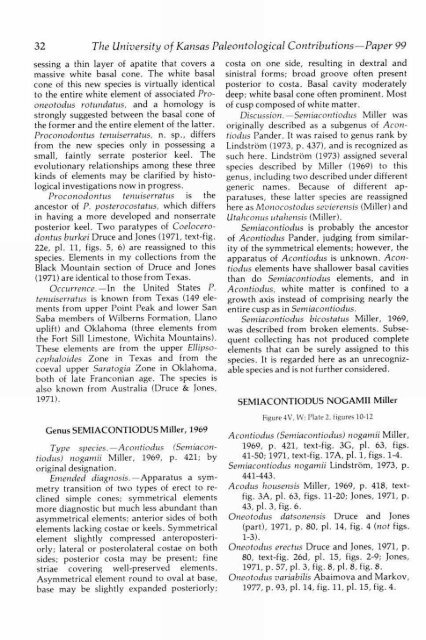View - KU ScholarWorks - University of Kansas
View - KU ScholarWorks - University of Kansas
View - KU ScholarWorks - University of Kansas
Create successful ePaper yourself
Turn your PDF publications into a flip-book with our unique Google optimized e-Paper software.
32 The <strong>University</strong> <strong>of</strong> <strong>Kansas</strong> Paleontological Contributions-Paper 99<br />
sessing a thin layer <strong>of</strong> apatite that covers a<br />
massive white basal cone. The white basal<br />
cone <strong>of</strong> this new species is virtually identical<br />
to the entire white element <strong>of</strong> associated Prooneotodus<br />
rotundatus, and a homology is<br />
strongly suggested between the basal cone <strong>of</strong><br />
the former and the entire element <strong>of</strong> the latter.<br />
Proconodontus tenuiserratus, n. sp., differs<br />
from the new species only in possessing a<br />
small, faintly serrate posterior keel. The<br />
evolutionary relationships among these three<br />
kinds <strong>of</strong> elements may be clarified by histological<br />
investigations now in progress.<br />
Proconodontus tenuiserratus is the<br />
ancestor <strong>of</strong> P. posterocostatus, which differs<br />
in having a more developed and nonserrate<br />
posterior keel. Two paratypes <strong>of</strong> Coelocerodontus<br />
burkei Druce and Jones (1971, text-fig.<br />
22e, pl. 11, figs. 5, 6) are reassigned to this<br />
species. Elements in my collections from the<br />
Black Mountain section <strong>of</strong> Druce and Jones<br />
(1971) are identical to those from Texas.<br />
Occurrence. -In the United States P.<br />
tenuiserratus is known from Texas (149 elements<br />
from upper Point Peak and lower San<br />
Saba members <strong>of</strong> Wilberns Formation, Llano<br />
uplift) and Oklahoma (three elements from<br />
the Fort Sill Limestone, Wichita Mountains).<br />
These elements are from the upper Ellipsocephaloides<br />
Zone in Texas and from the<br />
coeval upper Saratogia Zone in Oklahoma,<br />
both <strong>of</strong> late Franconian age. The species is<br />
also known from Australia (Druce 8,z Jones,<br />
1971).<br />
costa on one side, resulting in dextral and<br />
sinistral forms; broad groove <strong>of</strong>ten present<br />
posterior to costa. Basal cavity moderately<br />
deep; white basal cone <strong>of</strong>ten prominent. Most<br />
<strong>of</strong> cusp composed <strong>of</strong> white matter.<br />
Discussion. - Serniacontiodus Miller was<br />
originally described as a subgenus <strong>of</strong> Acontiodus<br />
Pander. It was raised to genus rank by<br />
LindstrOm (1973, p. 437), and is recognized as<br />
such here. LindstrOm (1973) assigned several<br />
species described by Miller (1969) to this<br />
genus, including two described under different<br />
generic names. Because <strong>of</strong> different apparatuses,<br />
these latter species are reassigned<br />
here as Monocostodus sevierensis (Miller) and<br />
Utahconus utahensis (Miller).<br />
Semiacontiodus is probably the ancestor<br />
<strong>of</strong> Acoritiodus Pander, judging from similarity<br />
<strong>of</strong> the symmetrical elements; however, the<br />
apparatus <strong>of</strong> Acontiodus is unknown. Acontiodus<br />
elements have shallower basal cavities<br />
than do Semiacontiodus elements, and in<br />
Acontiodus, white matter is confined to a<br />
growth axis instead <strong>of</strong> comprising nearly the<br />
entire cusp as in Semiacontiodus.<br />
Semiacontiodus bicostatus Miller, 1969,<br />
was described from broken elements. Subsequent<br />
collecting has not produced complete<br />
elements that can be surely assigned to this<br />
species. It is regarded here as an unrecognizable<br />
species and is not further considered.<br />
SEMIACONTIODUS NOGAMII Miller<br />
Genus SEMIACONTIODUS Miller, 1969<br />
Type species. -Acontiodus (Serniacontiodus)<br />
nogamii Miller, 1969, p. 421; by<br />
original designation.<br />
Emended diagnosis. -Apparatus a symmetry<br />
transition <strong>of</strong> two types <strong>of</strong> erect to reclined<br />
simple cones; symmetrical elements<br />
more diagnostic but much less abundant than<br />
asymmetrical elements; anterior sides <strong>of</strong> both<br />
elements lacking costae or keels. Symmetrical<br />
element slightly compressed anteroposteriorly;<br />
lateral or posterolateral costae on both<br />
sides; posterior costa may be present; fine<br />
striae covering well-preserved elements.<br />
Asymmetrical element round to oval at base,<br />
base may be slightly expanded posteriorly;<br />
Figure 4V, W; Plate 2, figures 10-12<br />
Acontiodus (Semiacontiodus) nogamii Miller,<br />
1969, p. 421, text-fig. 3G, pl. 63, figs.<br />
41-50; 1971, text-fig. 17A, pl. 1, figs. 1-4.<br />
Semiacontiodus nogamii Lindstr6m, 1973, p.<br />
441-443.<br />
Acodus housensis Miller, 1969, p. 418, textfig.<br />
3A, pl. 63, figs. 11-20; Jones, 1971, p.<br />
43, pl. 3, fig. 6.<br />
Oneotodus datsonensis Druce and Jones<br />
(part), 1971, P. 80, pl. 14, fig. 4 (not figs.<br />
1-3).<br />
Oneotodus erect us Druce and Jones, 1971, p.<br />
80, text-fig. 26d, pl. 15, figs. 2-9; Jones,<br />
1971, p. 57, pl. 3, fig. 8, pl. 8, fig. 8.<br />
Oneotodus variabilis Abaimova and Markov,<br />
1977, p.93, pl. 14, fig. 11, pl. 15, fig. 4.
















